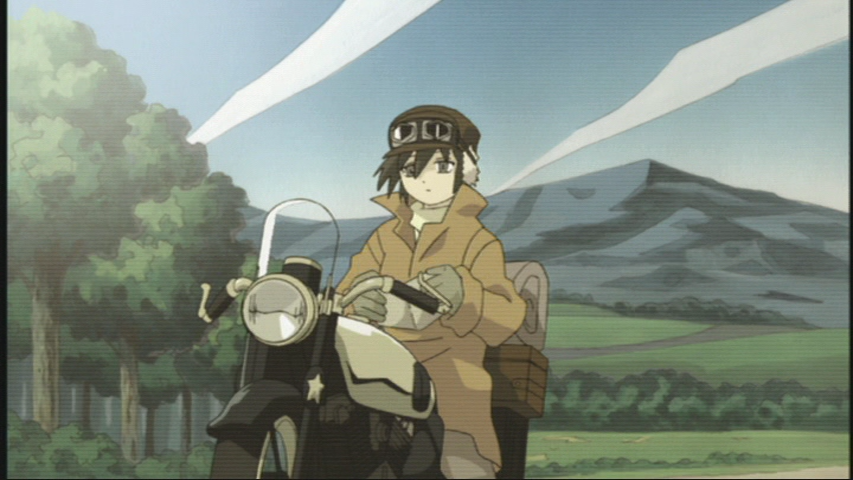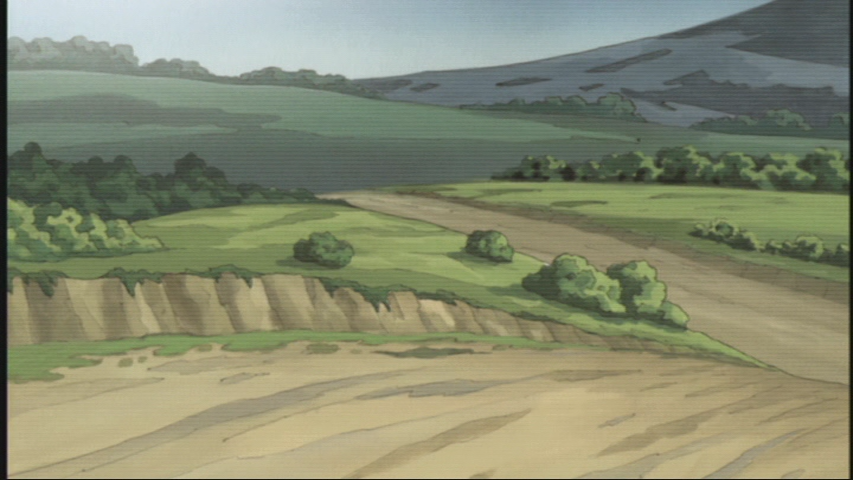Kino’s Journey (2003) Review
As I write this review, I admit that the only reason I knew of Kino’s Journey was because of the new anime adaptation that aired last season. While I didn’t watch this new adaptation, I was intrigued by what I heard from fans of the franchise, so I decided to review the original 2003 series. Has this series aged well, and how does it treat a newcomer like me? Let’s find out!
Kino’s Journey follows the adventures of protagonist Kino and their talking motorcycle, Hermes. Together the two travel through a variety of countries and forests, learning about what makes every place unique and hearing interesting stories from those they encounter. The sole rule the two follow is that they only stay in one town for three days and two nights, as Kino believes that this is long enough to learn everything important about a place.

Beyond a single two-part story, every other episode of this 13 episode series is standalone, with each story being unconnected and very episodic in nature. This is an approach that both helps and hinders the show for me, as I find this means that Kino is never greatly developed (beyond an episode explaining their backstory), but at the same time I wonder if that even matters. Kino’s Journey is less about Kino and far more about the counties we visit and the traditions they hold.
In every country we visit there is something strange going on. While the towns may seem happy and cheerful on the surface, underneath there is often a harsher reality and one that seeks to question humanity and the choices we often make. In all of the 12 stories on offer here (given that one is a two-parter), only one of them is a genuinely peaceful tale with a happy ending. The rest start out fairly well and then devolve to quite dark subjects, such as one early story that deals with the idea of human cannibalism.

Despite all the awful things we see through Kino’s journey, our protagonist still firmly believes that the world is beautiful, a sentiment that I think the show hopes viewers will come away with. It’s tough for me because Kino’s Journey is about metaphors and symbolism above all else and that is often quite hard for me to get my head around, especially when it’s not obvious – which it often wasn’t here. I didn’t come away with the opinion that the world is beautiful, but instead I was left with the impression that humanity can be incredibly ugly and twisted. That said, this is definitely a series that will mean different things to different people and it’s entirely possible that someone else watching it would find the different subjects fascinating and potentially inspiring.
Kino’s Journey has been animated by A.C.G.T (Freezing, Dies Irae) and overall the show has aged okay. This is mostly due to the fact it was already widescreen, whereas other shows from its era still weren’t (one notable example being the original Fullmetal Alchemist), so it looks less dated in that regard than it might have otherwise. The actual colour variation is very bland with a lot of muted colours, and even beyond that there is an odd, static-y look to the visuals, which is mildly off-putting and appears to be native to the animation rather than a problem with the release.

The music for the series has been handled by Ryo Sakai (I couldn’t find any examples of other work he’s done that has been released in English), and it leaves a lot to be desired. The selection of music on offer is rather small, and, more often than not, completely forgettable. Meanwhile the opening theme is “All the way” by Mikuni Shimokawa while the ending theme is “the Beautiful World” by Ai Maeda (who voices Kino). Both tracks are ballads and work lyrically with the themes of the show really well.
With only two main characters, there aren’t a great deal of voice actors to talk about, but Kino’s actor Ai Maeda (who hasn’t voiced any other roles of note), plays the character well. While she doesn’t give Kino a great deal of emotion, this actually works in the character’s favour as Kino does come across as having a stoic personality. Kino’s English voice actor, Kelli Cousins (again, no other notable anime roles to speak of), also plays the character well, albeit with a more girly tone than the Japanese VA, and given Kino is meant to have an ambiguous gender, this could be slightly off-putting to some.

This release comes to the UK thanks to Anime Limited, and is available on DVD only. The set includes all 13 episodes of the series with both its Japanese and English dub, and extras include cleaning opening and ending videos, as well as a video feature showing production sketches.
Overall, Kino’s Journey is a thought-provoking look at ‘what ifs?’ and the inner workings of the human mind. With a fantastical and mystical approach added in for some truly odd stories, it’s a series that is perfect for those into symbolism and strong metaphors. For everyone else, the show comes off as fairly depressing and at times difficult to watch, but there is certainly value to be found. It might not be for everyone, but Kino’s Journey is still something worth giving a watch.


